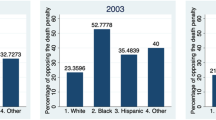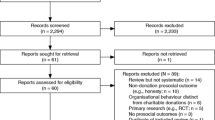Abstract
Jewish philanthropy to Israel, as measured by the annual United Jewish Appeal (UJA) campaigns, declined in the 1990s. A model of donors’ costs of gathering and updating stocks of information about recipients predicts both the centralized structure of general Jewish philanthropic giving (the Federation system) and the recent shifts away from giving through umbrella organizations. Donors have been changing the paths of donations, increasing their giving directly to foreign groups like the “Friends of ...f#x201D; organizations. While the UJA has had lower amounts to send to Israel, the decline has been more than compensated for by increases in such direct giving to Israel, even when measured in real terms.
Similar content being viewed by others
References
Azzi, Corry and Ronald Ehrenberg. (1975). “Household Allocation of Time and Church Attendance.”Journal of Political Economy 83 (1): 27–56.
Bank of Israel. (1998).Bank of Israel Annual Report 1997, Jerusalem. March.
Biddle, Jeff E. (1992). “Religious Organizations,” inWho Benefits from the Nonprofit Sector? edited by Charles T Clotfelder. Chicago, Illinois: University of Chicago Press.
Chiswick, Barry R. (1991). “An Economic Analysis of Philanthropy” inContemporary Jewish Philanthropy in America c.
Chiswick, Barry R. and Carmel U. Chiswick. (1998). “The Cost of Living Jewishly and Jewish Continuity.” April. Mimeo. Chiswick, Carmel U. (1996). “Israel and American Jewry in the Year 2020: An Economic Analysis,” inIsrael 2020: Master Plan for Israel in the 21st Century, The Macro Scenarios, Israel and the Jewish People edited by Anat Gonen, and Smadar Fogel: 1-15.
DellaPergola, Sergio, and Uzi Rebhun. (1994). “Israel and Diaspora Relationships: A First Quantitative Analysis of Social Indicators.”Occasional Paper 13, Division of Jewish Demography and Statistics, The Avraham Harman Institute of Contemporary Jewry, The Hebrew University of Jerusalem.
Elazar, Daniel J. (1995).Community and Polity: The Organizational Dynamics of American Jewry. Philadelphia, PA: The Jewish Publication Society.
Forbes, Kevin F. and Ernest M. Zampelli. (?) “Religious Giving by Individuals,”American Journal of Economics and Sociology. Vol. 56, no. 1 (January): 17–30.
Greenberg, Richard. (1998). “I’ll Give It My Way,”Moment. Vol. 23, no. 6 (December): 50–59.
Hausman, Tamar. (1998). “U.S. Jews Refocus Donations to Israel, Shifting to Nongovernmental Causes,”The Wall Street Journal, 5 October: A22.
Iannaccone, Laurence R. (1992). “Sacrifice and Stigma: Reducing Free-Riding in Cults, Communes, and Other Collectives,”Journal of Political Economy. 100 (2): 271–291.
Katz, Israel. (1991). “Israeli Society and Diaspora Philanthropy: How Well Does the Gift Perform” inContemporary Jewish Philanthropy in America edited by Barry A. Kosmin, and Paul Ritterband. Savage, Maryland: Rowman and Littlefield Publishers, Inc.
Kosmin, Barry A., and Ritterband, Paul. (1991). eds.,Contemporary Jewish Philanthropy in America. Savage, Maryland: Rowman and Littlefield Publishers, Inc.
Rimor, Mordechai, and Tobin, Gary A. (1991). “The Relationship Between Jewish identity and Philanthropy” inContemporary Jewish Philanthropy in America edited by Barry A. Kosmin, and Paul Ritterband. Savage, Maryland: Rowman and Littlefield Publishers, Inc.
Ritterband, Paul. (1991). “The Determinants of Jewish Charitable Giving in the Last part of the Twentieth Century” inContemporary Jewish Philanthropy in America edited by Barry A. Kosmin, and Paul Ritterband. Savage, Maryland: Rowman and Littlefield Publishers, Inc.
Ritterband, Paul, and Cohen, Steven M. (1979). “Will the Well Run Dry?”Response. Summer: 9-17.
Roberts, Russell D. (1984). “A Positive Model of Private Charity and Public Transfers,”Journal of Political Economy. Vol. 92, no. 1 (February): 136–148.
Varese, Federico and Meir Yaish. (1998). “Altruism: The Importance of Being Asked. The Rescue of Jews in Nazi Europe.”Discussion Papers in Economic and Social History. No. 24 (May). University of Oxford.
Wertheimer, Jack. (1997). “Current Trends in American Jewish Philanthropy”American Jewish Year Book 1997. New York: American Jewish Committee: 3–92.
Author information
Authors and Affiliations
Additional information
This paper was prepared for the Conference on the Economics of Judaism and Jewish Observance, Bar-Ilan University and the University of Illinois at Chicago, December 13-16, 1998. I’d like to thank conference participants and the El AI security personnel at Newark airport. Special thanks are due to Carmel U. Chiswick and Barry R. Chiswick for helpful discussions and background information. All errors and omissions are, of course, my own.
Rights and permissions
About this article
Cite this article
Roberts, H. American Jewish donations to Israel. Cont Jewry 20, 201–213 (1999). https://doi.org/10.1007/BF02967965
Issue Date:
DOI: https://doi.org/10.1007/BF02967965




